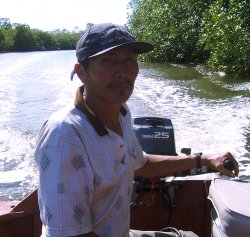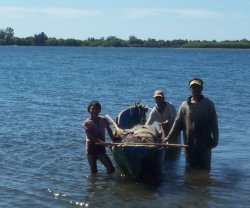Lazy Days on the Estero Padre Ramos

If you could go back in time about 500 years and walk up the shoreline of the Estero Padre Ramos (on Nicaragua’s Pacific Shore) you would meet someone like don Carlos. A slightly built man whose layers of tight muscle are stretched taut over a wiry frame, Carlos is laconic and polite, thoughtful and austere. His hand on the tiller of a 25 horsepower Yamaha outboard he carried down to the shore on his bronzed shoulder, he carries us out into the estuary and up the tributaries that carry fresh water down into the mangroves and the wetlands that make up one of Nicaragua’s most gorgeous corners. Indigenous traits feature strongly in his features, from the sharp black hair to the high cheekbones. He chooses his words carefully, feels strongly about the estuary, which has been his home since his childhood, and his family’s home for many generations before that.
“There’s good fishing up in that area,” he gestures with one hand, “but there are ‘gators too. We found one as long as this boat – about 8 feet – including his tail. Guess he likes the small birds.” If there are other good fishing spots, Carlos doesn’t mention them, but it’s not because we are competition for his family, who has lived off the sea for generations, it’s because there is no need to say it. His gaze wanders out to the mouth of the estuary, where sea surf pounds on the labrynth of shifting sandbars that delimit the edge of the Pacific. “That’s where we found the drowning victims,” he remembers. A fisherman by trade, drownings are part of the seascape, but these were different, illicit Peruvians bound for California and the undocumented labor pool. Their boat capsized in the surf at night, and all of them – about a dozen – drowned.
The Estuary is gorgeous, rife with egrets and herons and lots of birds too fast or too small to positively identify. We saw a hawk drawing lazy circles over the mangroves, and the tracks of pipers in the dark volcanic sand that made up a dozen small islets in the south. The mangroves are particularly inhospitable for humans – one of very few landscapes that have much hope of resisting human encroachment – and within their snarled roots and branches, so frequently indistinguishable from each other, an unparalleled range of wildlife live their quiet existences under the twin shadows of Volcán Cosigüina and Volcán San Cristobal. The landscape has a primeval look to it, but it is intensely alive in all aspects.
 Don Carlos and his kin are as much a part of the landscape as the mangroves are. He knows the water like the back of his hand, goes out to sea in small boats to catch fish he know by their indigenous names, like Guirango instead of Pargo Rojo (red snapper), returns home to a simple home he built himself on the shoreline, his Salvadoran wife, and his four little girls. His wife’s nationality is almost inconsequential this close to the border, and he and his family travel back and forth between both countries placidly, as if the only thing that separated one from the other was the Gulf of Fonseca, not politics. Five hundred years ago, he would’ve been right.
Don Carlos and his kin are as much a part of the landscape as the mangroves are. He knows the water like the back of his hand, goes out to sea in small boats to catch fish he know by their indigenous names, like Guirango instead of Pargo Rojo (red snapper), returns home to a simple home he built himself on the shoreline, his Salvadoran wife, and his four little girls. His wife’s nationality is almost inconsequential this close to the border, and he and his family travel back and forth between both countries placidly, as if the only thing that separated one from the other was the Gulf of Fonseca, not politics. Five hundred years ago, he would’ve been right.
Tourism offers a hopeful alternative source of income to people like don Carlos as Nicaragua grows and the economy strengthens. The estero is a fragile ecosystem that can only withstand the increased pressure of the burgeoning Nicaraguan population to a certain point. You can overfish an estuary as easily as you can overfish the oceans. In the meantime, Don Carlos will continue to live his days as he always has, and every one of them will make sense to him.
Trackbacks
The author does not allow comments to this entry

Comments
Display comments as Linear | Threaded